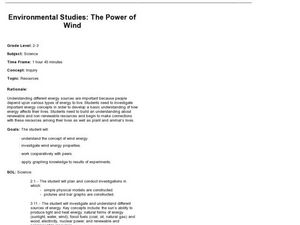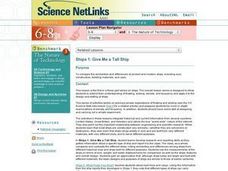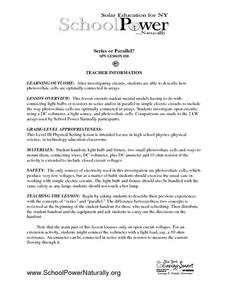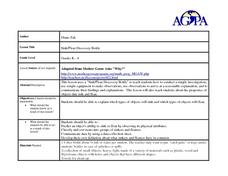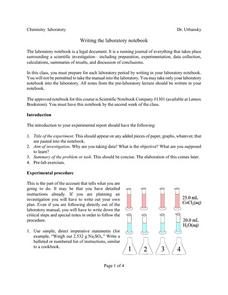Curated OER
Environmental Studies: The Power of Wind
Investigate the prospect of wind as a renewable resource. Second and third graders make a pinwheel, answer critical thinking questions, and then attempt to use wind power to wind string. I would be more apt to use this lesson in a 1st or...
Curated OER
Give Me a Tall Ship
Sixth graders develop an understanding of floating, sinking, density, and buoyancy and apply it to the design of testing of ships.
Curated OER
Raindrops Keep Falling on my Art
Kids may be a little resistant to this rainy day idea, but it could produce some amazing art. They paint a watercolor picture of anything they like. When they are done, they take their paintings outside and let the rain work its magic!...
Curated OER
All Ears for Adaptation
Young scholars discuss different characteristics that enable animals to adapt to their environments. They work in pairs with one partner standing about one foot behind the other partner and cup their hands around their ears with palms...
Curated OER
Design Challenge: Cup in the Cupboard
Students design device that will place a cup into a cupboard for a physically challenged person. They study the engineering design and how structure relates to function.
Curated OER
Why did the can crush?
Students watch a demonstration to ascertain why a soda can crushed. They make observations and hypothesize about why a soda can crushed and relate the difference in pressure to its affect on objects around us (soda can). Explanation is...
Curated OER
Series or Parallel?
Physics classes that are studying electricity connect photovoltaic cells into both series and parallel circuits. Inquiry and critical thinking come into play as learners try to determine which circuit is more productive. They associate...
Curated OER
Don't Slip!
Students measure, record, and graph the force of moving a block of wood along sand paper. In this friction lesson plan, students read a spring scale, collect data, construct a graph, and propose a model to explain how fiction works.
Curated OER
What's Cooking?
Students investigate solar energy by making sun tea. In this ecology and solar energy lesson, students prepare traditional tea and "sun" tea, then record and graph data comparing color, clarity, smell and taste.
Curated OER
Matter
First graders are read a story about the various stages of matter with a focus on gases. Using a ziploc bag, they capture as much air as possible and discuss how it takes up space even though it is invisible. To end the lesson plan, they...
Curated OER
Forces, Controls And Aircraft Systems
Students are introduced to the physics of flight through video and PowerPoint presentations. They construct and fly model gliders and compete for height, distance, time, etc.
Curated OER
Simplicity of Electricity
Students examine how to make an electrical circuit. They listen to a teacher led discussion, design a switch to control a circuit, and construct a signaling device.
Curated OER
Sink/Float Discovery bottle
Investigate which items float and which ones sink using this resource. Learners participate in an activity in which they investigate this phenomena. Then they describe the experimental process, and learn how to display their results.
Curated OER
Loud or soft?
Send this cute activity home with kids, to increase family involvement. They'll consider what would happen if rice was bounced in a tambourine, and then they'll complete a sound activity by makings an instrument out of wax paper and a...
Curated OER
Who Done It?
Pick and choose which activities to include in this crime scene investigation. Junior detectives can examine fingerprints, DNA, blood samples, or bone structure. The plan suggests you have teams solve a mystery, but it does not give you...
Curated OER
Sorting
Learners examine the concept of organization. In this library skills lesson, students practice ordering and sorting skills by playing the Flood Game.
Curated OER
Properties of Matter
Ninth graders explore the molecular structure of matter and how it can affect the physical characteristics of a specific material. They demonstrate that isotopes of an element have different masses. Students demonstrate that the rates of...
Curated OER
Pick a Pet
Students design informational materials to educate people on the importance of matching a new pet to the family's lifestyle and living arrangements. Students use critical thinking skills to make a decision on the appropriate choice for a...
Curated OER
Inviting Butterflies to the Schoolyard
Students create a butterfly garden. In this butterfly garden lesson, students plot a garden with plant species that will attract butterflies. Students learn about the specific plants and items that will help butterflies use the garden.
Curated OER
Understanding Waves
Learners examine the physical properties of waves to explore the word crest and trough. They use toys to study waves in air, water and light.
Curated OER
Bird Seed Mining
Learners search through the seed mixture and separate out our "mine" beads, sunflower seeds, and other grain products, making piles of each. students count up the number of gold, silver, and blue beads, and sunflower seeds from their piles
Curated OER
Super Gelatin
Students investigate the refraction properties of gelatin to calculate its index of refraction. They discover that as the light travels through the gelatin, its speed and wavelength also change. Students find th indes of refraction of an...
Curated OER
Writing The Laboratory Notebook
In this chemistry worksheet, learners examine the given concept in order to apply in the laboratory setting. The sheet includes in depth background information.
Curated OER
The Mole
This compact collection of slides explains the history and use of the mole unit. Relative atomic mass, as John Dalton understood it, is explained. Avogadro's number is also introduced. The mole, or the unit for the amount of a substance,...


